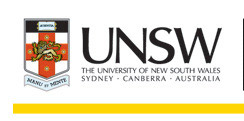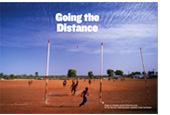Once were worriers – Australia’s golden age of economic policy making.
By Tim Harcourt*
We are not winning the Ashes or the Rugby but in terms of economic management Australians are world beaters. But you wouldn’t know it from all the gloomy economic talk in the press sapping business and consumer confidence.
In case you missed it Australia unlike many other industrialised countries avoided the worst economic crisis that has bedevilled the global economy since the Great Depression (note the term they use in the USA – ‘the Great Recession’ – rather than the more technical and even benign sounding ‘GFC’ that we use in Australia).
So what? Well if you want to think about what could have happened go to a European country like Greece or Spain or check out the more depressed areas of the UK or the USA. Or even closer to home, take a look the excellent ABC show ‘The Years That Made Us’ by Chris Masters on Australia’s own experience during the Great Depression itself. Masters uses his own family and community to explain the hardship that beset working Australians as result of the international economic crisis following the Wall Street crash of 1929.
In fact the only thing missing in Masters’ excellent oral history was a discussion of economic policy in the 1930s – the very core of Australia’s recent success as a nation.
In the Great Depression of the 1930s there was massive unemployment (Australia had one of the highest levels in the industrialised world) and Australian governments on the advice of Australia’s fledgling economics community did the worst things possible in terms of policy.
In what we would call an “austerity plan” today the Commonwealth and State governments cut government spending, tightened credit, kept the exchange rate fixed, cut wages (the Arbitration Court actually tried to implement a 10 per cent cut in the Basic Wage in 1931) and jacked up tariffs.
As a result the slump in Australia was longer and deeper than it should have been and it eventually took putting the economy on a war footing in World War 2 to get out of it
By contrast in 2008 facing the financial turmoil of the sub prime Australia economic management was world class.
Economic policy makers did the exact opposite of what was tried in the 1930s.
They increased government spending through a well timed and well targeted stimulus packages in the advice proffered by then Treasury Secretary Dr Ken Henry to “Go hard, go early and go households.”
And it worked. The Nobel Laureate Professor Joseph Stiglitz when visiting Australia in 2010 said Australia was “lucky to have, probably the best designed stimulus package of any of the countries, advanced industrial countries, both in size and in design, timing and how it was spent and I think it served Australia well.” (I interviewed Stiglitz on that trip to Australia and he said he was “widely impressed with the state of economic and social policy” and had taken a special interest in indigenous labour market policy “where most work clearly needs to be done in the long term.”
As well as the fiscal stimulus, the RBA did their bit by quickly loosening monetary policy.
Wages were able to rise in line with productivity and minimum wages was adjusted upward rather than cut.
The flexible exchange regime introduced by the Hawke-Keating government meant the dollar could weaken and act as a ‘shock absorber’ to contain the external impact of the crisis (as it also did during the Asian Financial Crisis of 1997-99 when Australian exports got badly bruised by events in Asia).
And tariffs were kept low and our commitment to an open economy was strengthened in the Doha WTO talks. As then Trade Minister Simon Crean said at the time, “trade could act as an additional stimulus” globally when demand was depressed in the worst affected economies.
And our unsung heroes, the Australian exporter community actually adjusted to changing global conditions by cutting hours rather than jobs to minimise the overall pain in the Australian labour market.
The whole package of this period – fiscal, monetary, wages and international trade policy – worked a treat in contrast to the Premiers Plan and the associated austerity package implemented by Australian governments in the 1930s urged on then by the economics profession.
In fact, the response to the GFC by Australia represents an innovative period in the history of Australian economic policy making. And overcame past doubts about the efficacy of fiscal stimulus in a global crisis.
As Dr Ken Henry says in his keynote address to the Symposium in honour of Professor JW Nevile here at UNSW:
“…the government and its advisers are in no doubt that without the large fiscal stimulus, and its having been delivered in such a timely fashion, the Australian economy would have suffered a very deep recession.
Yet the scepticism about the efficacy of the fiscal response is understandable: like many other countries, Australia has a poor history of fiscal activism; indeed, this recent period might be the only instance in Australia’s history of a fiscal stimulus having insulated the economy from an external shock that would otherwise have produced a deep domestic recession. That is to say, it could be a unique achievement.”
The success of this golden age of economic policy making is outlined by Jim Chalmers in his excellent new book ‘Glory Daze’ (anyone who can work in a Bruce Springsteen song into the title of an economics book gets my vote!).
In Glory Daze, Chalmers outlines how the politicians (despite interpersonal rivalries so well documented now) kept their cool and worked together with the Treasury and RBA – as well as with officials in financial and political capitals around the world as international coordination of policy making was transformed. As a by product we now have a restructuring of international economics institutions with the resulting rise of the G 20 as a preeminent global policy making body.
Chalmers narrative is lively and dramatic – a real “West Wing” of Australian economic policy making as Australia bucked the global trend and avoided recession
And most importantly all that frantic energy and drama was worth it because it worked.
As evident in a new paper by my colleague Professor Raja Junankar at UNSW,
Australian avoided the contraction and mass unemployment that has plagued other advanced industrial economies since the 2008 crash.
According to Junankar, when you compare Australia with other advanced industrialised economies like the US, UK, and both strong and weak economies in Europe (e.g. from Germany to the crisis ridden economies in the south next to the Mediterranean ) we score better in terms of GDP, employment, inflation, current account, budget deficits and debt ratios. As Junankar says: “Even the ‘wunderkind’ Germany took three years before its GDP returned to the pre-2008 levels….All other countries had higher unemployment rates than Australia in the post-2008 period.”
Junankar notes praise for Australia in official international policy circles including the OECD which says: “With 21 years of uninterrupted growth Australia stands out among OECD countries.”
So there you have it, when it comes to economic management in recent times, Australia is outstanding by international standards.
But why is the story not better known?
The answer is Rats, Rent seekers and the Rabid 24 hour news cycle.
There is clearly a disconnect between the evidence of our economic success and the plethora of survey and campaigns to illustrate hardship, pessimism a lack of business and consumer confidence or alleged government waste.
As market economist Adam Carr says in Glory Daze:
“Pessimism is a disease in this country and like rats, lacklustre economists are playing a significant role in spreading it.”
And behind every rat plugging a business confidence survey is a rent seeker. Rent seekers aim to capture rents and redistribute income and wealth their way at the expense of others with no net welfare gain to society. You see it in changes to laws and taxes. You even see it in the exchange rate. Retailers like Gerry Harvey of Harvey Norman will bemoan a high dollar as his retail outlets can’t then compete with online imports from the USA (especially with different tax treatment) and make claims on the government and the RBA to “do something about it”. The issue facing Harvey Norman may be structural – due to long terms industry trends in retail and the rise of the online global consumer – but it is still easier to blame the government and the RBA.
Put the rats and rent seekers together with the rabid nature of the 24 hours news cycle with hysteria about polls and surveys, a bit of a gotcha journalism, and some hyper partisan opinion dressed up as ‘analysis’.
There is also a fair bit of irresponsible economic commentary around by people who should know better. Recently, the shadow Treasurer Joe Hockey said that the Australian economy is ‘volatile’, because of recent changes in the exchange rate. As demonstrated at a time of turmoil in most advanced industrialised economies, Australia has an enviable record in terms of economic growth and employment and the movements in the floating exchange rate have saved us from serious ruptures in the real economy.
The recent period of Australian economic management should be one of the proudest moments in our history. Over time economic historians will find this to be the case and we will revel in just as we did about Hawke Keating reforms and the like. But it’s a debate we have to have now because otherwise we’ll miss one of Australia’s greatest moments in history, a moment captured in our own lifetime (and outlined brilliantly by George Megalogenis in his book ‘The Australian Moment’). But if we miss it or fail to realise it we might fall into the same trap as the austerity ridden economies like the UK that may have a new Royal Baby and the Ashes but not the jobs to go to after the celebrations are over.
*Tim Harcourt is the JW Nevile Fellow in Economics at the Australian School of Business, UNSW, Sydney, Australia & author of The Airport Economist www.theairporteconomist.com













No Comments so far ↓
Comments are closed.